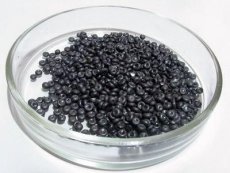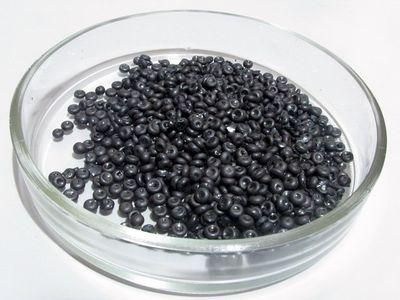Medical expert of the article
New publications
How does selenium affect the body?
Last reviewed: 26.02.2024

All iLive content is medically reviewed or fact checked to ensure as much factual accuracy as possible.
We have strict sourcing guidelines and only link to reputable media sites, academic research institutions and, whenever possible, medically peer reviewed studies. Note that the numbers in parentheses ([1], [2], etc.) are clickable links to these studies.
If you feel that any of our content is inaccurate, out-of-date, or otherwise questionable, please select it and press Ctrl + Enter.

Selenium in the protein
Selenium is part of proteins to create selenoproteins, which are important antioxidant enzymes. The antioxidant properties of selenoproteins can help prevent damage to cells from free radicals. Free radicals are natural byproducts of oxygen metabolism, which contribute to the development of chronic diseases, such as cancer and heart disease. Other selenoproteins help regulate thyroid function and play an important role in the functioning of the immune system.
What products provide selenium?
Vegetable products are the main food sources of selenium in most countries around the world. The content of selenium in food depends on the content of selenium in the soil where the plants are grown. For example, researchers know that soils in the high plains of northern Nebraska and Dakota have a very high level of selenium. People living in these regions tend to consume the most selenium in the United States of America.
Soils in some parts of China and Russia contain a very low amount of selenium. Selenium deficiency is often found in these regions, because most of the food in these areas is grown and eaten at the local level.
Selenium can also be found in some types of meat and seafood. Animals that eat grains or plants that were grown in selenium-rich soils contain a higher level of selenium in the muscles. In the US, meat and bread are common sources of food selenium. Some nuts are also sources of selenium.
The content of selenium in products may vary. For example, Brazil nuts can contain 544 micrograms of selenium per ounce. It is advisable to eat Brazil nuts only occasionally, because these are products with an unusually high content of selenium.
The daily norm of selenium
The daily norm for selenium is 70 micrograms (μg). Most food labeling does not show the content of selenium in food. The percent of daily value (% DV) indicated in the table indicates the percentage of daily intake presented in one portion. Food provides 5% of selenium from the daily allowance. Food that provides a 20% or higher daily selenium rate is too nutritious. It is important to remember that foods that provide a lower percentage of the daily intake of selenium also contribute to a healthy diet.
|
The product's name |
Mkg |
% Daily Value |
|---|---|---|
| Brazil nuts, dried | 544 | 39 |
| white meat, fried | 27th | 39 |
| Chicken breast, fried meat | 24 | 34 |
| Beef roast | 23 | 33 |
| Sunflower seeds | 23 | 33 |
| Egg noodles, enriched, boiled, ½ cup | 19 | 27th |
| Pasta, fortified, boiled, ½ cup | 19 | 27th |
| Egg, whole, hard boiled | 15 | 21 |
| Oatmeal cooked, 1 cup | 12 | 17th |
| Bread from whole grains, 1 slice | eleven | 16 |
| Rice, brown, long grain, cooked, ½ cup | 10 | 14 |
| Rice white, enriched, long-grain, cooked, ½ cup | 6th | 9 |
| Walnuts | 5 | 7th |
| Cheese Cheddar | 4 | 6th |
Recommendation dietary consumption of selenium
The norms of selenium consumption are a common term for a set of reference values used to plan and evaluate nutrients for healthy people. Three important types of reference values included in Dietary Allowances (RDA) are the norm of adequate intake (MA), the upper permissible level of consumption (UL). The RDA recommends an average daily dietary intake sufficient to meet nutritional requirements for almost all (97% -98%) of healthy people in each group, given their age and sex.
The maximum daily dose is unlikely to lead to adverse health effects. The table lists the norms for selenium in micrograms (μg) per day for children and adults.
| Age (years) | Men and women (Mkg per day) | Pregnancy (Mqg per day) | Lactation (mg / day) |
|---|---|---|---|
| 1-3 | 20 | N / A | N / A |
| 4-8 | thirty | N / A | N / A |
| 9-13 | 40 | N / A | N / A |
| 14-18 | 55 | 60 | 70 |
| 19+ | 55 | 60 | 70 |
Doses of selenium for infants
There is insufficient information on selenium, established in a dose for infants. Adequate intake is based on the amount of selenium consumed by healthy infants fed with breast milk. The table shows the norms of selenium for children in micrograms (μg) per day
| Age (in months) | boys or girls (Mkg per day) |
|---|---|
| 0-6 months | 15 |
| 7-12 months | 20 |
Selenium in the diet - research
The results of the US National Health and Nutrition Research show that the diet of most Americans provides the recommended amount of selenium. The study examined the nutritional intake of nearly 5,000 middle-aged men and women in four countries in the late 1990s, including the US, the main purpose of the study was to assess the effect of micronutrients on blood pressure.
Each participant of the study, after completing the 24-hour diet recalls that they asked to write down all the consumed foods (food, beverages and food additives) in the previous 24 hours. Consumption of selenium was the lowest among the inhabitants of China, the country with the highest deficit of selenium.
The average dose of selenium in the diet of American participants was 153 mcg for men and 109 mcg for women. Both values exceed the recommended intake of selenium for adults and are further evidence of adequate intake of selenium in the United States.
When can there be a deficit of selenium?
Deficiency of selenium is rare in the US, but there are other countries, especially in China, where the concentration of selenium in the soil is very low. There is evidence that a deficiency of selenium can contribute to the development of heart disease, hypothyroidism and weakening of the immune system. There is also evidence that selenium deficiency usually does not cause disease in itself. Rather, it can make the body more susceptible to illness caused by other nutritional, biochemical or infectious strains.
Three specific diseases are associated with a deficiency of selenium
- Keshan's disease, which leads to increased heart tissue and poor heart function, occurs in children with a deficiency of selenium
- Kashin-Beck disease, which leads to osteoarthropathy
- Endemic cretinism, which leads to mental retardation
History of diseases associated with selenium deficiency
Keshan's disease was first described in the early 1930s in China, and is still observed in large areas of a Chinese village with poor selenium soils. The dietary intake of selenium in these areas is less than 19 μg per day for men and less than 13 μg per day for women, significantly lower than the current dose of selenium. Researchers believe that selenium is not enough in people infected with the virus of Keshan's disease. Selenium deficiency is also observed in people who rely on parenteral nutrition (TPN) as the sole source of nutrition. TPN is a method of feeding nutrients through intravenous injections to people whose digestive system does not work.
Forms of nutrients that do not require digestion, dissolve in the liquid and pass through the veins by means of a dropper. This is important for securing selenium in order to prevent its deficiency. Doctors can monitor the condition of selenium for people receiving artificial feeding to make sure that they get enough of it.
Severe gastrointestinal disorders can reduce the absorption of selenium, resulting in selenium depletion or insufficiency. Gastrointestinal problems that interfere with the absorption of selenium usually affect the absorption of other nutrients, and also require regular monitoring of human nutrition so that they are provided with appropriate medical and nutritional treatment.
Who might need additional selenium?
In most cases, selenium depletion or its deficiency is associated with severe gastrointestinal problems, such as Crohn's disease or surgical removal of a part of the stomach. These and other gastrointestinal disorders can disrupt absorption of selenium. People with severe illness, who develop inflammation and spread infection, often experience a decrease in selenium levels in the blood.
Doctors separately control people who suffer from gastrointestinal diseases or severe infections as a result of a lack of selenium to determine the need for selenium supplements for them.
People with iodine deficiency can also benefit from selenium. Iodine deficiency is quite rare in the US, but is still prevalent in developing countries, where access to iodine is limited. Researchers believe that a deficiency of selenium can worsen the effect of iodine deficiency and thyroid function, and that adequate selenium nutrition can help protect a person from certain neurological consequences of iodine deficiency.
The researchers conducted a supplementation study in France that was designed to assess the effect of vitamin and mineral supplements on the chronic risk of the disease, they evaluated the relationship between goiter and selenium during this study. Their results show that selenium supplements can be protective against goiter, which is involved in enlarging the thyroid gland.
Although specific medical problems, such as those described above, indicate the need for selenium, there is insufficient evidence to develop recommendations for selenium supplements for healthy children and adults.
Selenium additives

Selenium is part of the main food products, such as corn, wheat, soy and selenomethionine, organic selenium - an analogue of the amino acid methionine. Selenomethionine can be metabolized by the body of v met Methionine and serves as a means for storing selenium in organs and tissues. Selenium additives can also contain sodium selenite and selenate, two inorganic forms of selenium. Selenomethionine, as a rule, is best absorbed and used as a form of selenium.
Most of the selenium in yeast exists in the form of selenomethionine. This form of selenium was used on a large scale for the prevention of cancer in 1983, in a study that showed that a daily intake of an additive containing 200 micrograms of selenium per day. It can reduce the risk of prostate, lung and colorectal cancer. However, some yeast may contain inorganic forms of selenium that are not used, as well as selenomethionine.
A 1995 study reported that the organic forms of selenium in the blood may contain an increased concentration of selenium to a greater extent than inorganic forms. However, this will not significantly improve the activity of selenium-dependent enzymes, such as glutathione peroxidase. Researchers continue to study the effect of various chemical forms of selenium, but selenium for humans in organic form is currently the best choice.
Selenium and Cancer
Experimental studies show that the death rate from cancer, including lung, colon and prostate cancer, is lower among people with high selenium intake. In addition, the incidence of skin cancer is significantly higher in areas of the United States with a low content of selenium in the soil. The effect of selenium on the repetition of various types of skin cancers was studied in seven US dermatological clinics from 1983 until the early 1990s. Taking daily supplements containing 200 micrograms of selenium does not affect the relapse of skin cancer, but also significantly reduces the occurrence and death of common cancer. The incidence of prostate cancer, colorectal cancer and lung cancer was significantly lower in the group receiving selenium supplements.
Studies show that selenium can affect the risk of developing cancer in two ways. As an antioxidant, selenium can help protect the body from the harmful effects of free radicals. Selenium can also prevent or slow the growth of the tumor.
Two long-term studies in France, the United States and Canada have investigated whether selenium, combined with at least one food supplement, can reduce the risk of prostate cancer in men.
Among men who had a selenium level in the blood at the beginning of the study, the use of supplements was associated with an increase in the incidence of prostate cancer at the border of statistical significance compared with placebo.
So, in the course of research, the number of new prostate cancer cells in healthy men aged 50 years and older decreased. The results of an additional 1.5 years of follow-up from this process (during which subjects did not receive vitamin E or selenium) showed that men who took one selenium or selenium plus vitamin E had a slightly increased risk of developing prostate cancer compared to men, who took a placebo, but the differences were not statistically significant. In men who took only vitamin E, the risk of developing prostate cancer was increased by 17%.
Selenium and heart disease
Long-term population surveys have shown a link between lower intake of antioxidants and a high incidence of cardiovascular disease. The data also show that oxidative stress from free radicals, which are natural byproducts of oxygen metabolism, can contribute to heart disease.
For example, these are oxidized forms of low density lipoproteins (LDL, often called "bad" cholesterol), which contributes to the development of plaques in the coronary arteries. Selenium is one of a group of antioxidants that can help limit the oxidation of "bad" cholesterol and thereby help prevent coronary artery disease. At present, there is insufficient evidence that recommends selenium supplements for the prevention of coronary heart disease.
Selenium and arthritis
Polls show that people with rheumatoid arthritis, a chronic disease that causes pain, stiffness, swelling and loss of function in the joints, have reduced the level of selenium in the blood. In addition, some people with arthritis have a low intake of selenium.
The body's immune system naturally makes free radicals that can help destroy the invasion of alien organisms and damaged tissues, but it can also damage healthy tissues. Selenium as an antioxidant can help alleviate arthritis symptoms by controlling the level of free radicals. Current results are considered preliminary, and further studies are needed before selenium supplements can be recommended for people with arthritis.
Selenium and HIV
HIV / AIDS can lead to depletion of nutrients, including selenium. Deficiency of selenium is associated with a decrease in the number of cells in the immune system, an increase in the progression of the disease and a high risk of death in the fight against HIV / AIDS.
HIV / AIDS is gradually destroying the immune system, and oxidative stress can further damage the cells of the immune system. Antioxidants, such as selenium, help protect cells from oxidative stress, thus potentially slowing the progression of the disease.
Selenium may also be necessary for the replication of the HIV virus, which could further reduce the level of selenium.
Examinations of 125 HIV-infected men and women showed that the higher mortality from this disease is associated with a deficit of selenium. In a small study of 24 children with HIV, which scientists observed for five years, children with a low level of selenium died in a younger age, which may indicate a faster progression of the disease. The results of the studies, which led the experts, suggest that the level of selenium can be a significant predictor of the survival of HIV-infected people.
Scientists continue to investigate the relationship between selenium and HIV / AIDS, including the effect of selenium on levels of disease progression and mortality. There is insufficient data to regularly recommend selenium supplements for people with HIV / AIDS, and doctors can prescribe such supplements as part of a general treatment plan. This is also important for HIV-positive people who consume the recommended amount of selenium in the diet.
What leads to an excess of selenium?
A high level of selenium in the blood (more than 100 μg / dL) can lead to a negative state. Symptoms of an overabundance of selenium include gastrointestinal disorders, hair loss, spotty nails, breath with a scent of garlic, fatigue, irritability and nerve damage.
Toxicity due to an overabundance of selenium is rare. Several cases were associated with industrial accidents and production errors, which led to excessively high doses of selenium. The Institute of Medicine of the National Academy of Sciences of the United States has established an upper permissible intake level (UL) of selenium at 400 mcg per day for adults to prevent the risk of selenium poisoning. The table shows the marginal rates of selenium consumption - in mcg per day for infants, children and adults.
| age | men and women (Mkg / day) |
|---|---|
| 0-6 months | 45 |
| 7-12 months | 60 |
| 1-3 years | 90 |
| 4-8 years | 150 |
| 9-13 years old | 280 |
| 14-18 years old | 400 |
| 19 + years | 400 |
Selenium and a healthy diet
In 2010, the federal government of the US Dietary Guidelines noted that "nutrients should be consumed primarily from foods.Nutrition with nutrients, mostly intact in their forms, contain not only the necessary vitamins and minerals that are often found in food additives , as well as in dietary fiber and other natural substances that can positively influence health .... Biologically active additives ... Can be beneficial in a particular situation to increase the consumption of a specific in itamin or mineral ".
Before using selenium - as an independent element or as part of other substances - be sure to consult with your doctor-dietitian.



 [
[